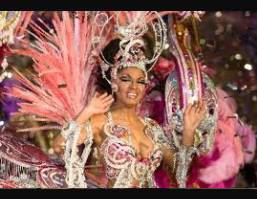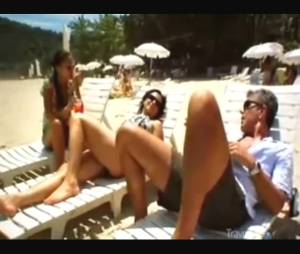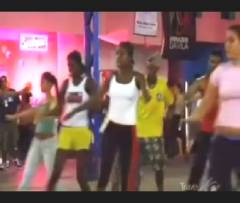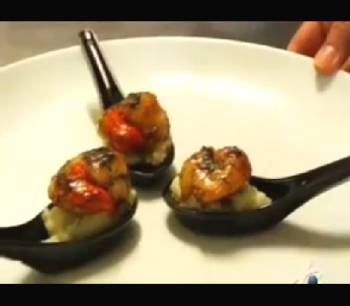Perhaps because São Paulo is sprawling like Los Angeles, it has been said, uncharitably, that São Paulo feels like Los Angeles threw up on New York City. The city is known for its unreliable weather, the size of its helicopter fleet, architecture, gastronomy, and multitude of skyscrapers.
This is Anthony Bourdain's second trip to the city. Anthony once thought São Paulo was a horrible and ugly city; however, recently his friends have convinced him otherwise. As he explores the city, he develops a fondness for the rich culture that has developed from the mix of rich and poor, young and old. Anthony starts to view São Paulo as a city of people, and it happens to be a city of the kind of people he likes a lot.
Introduction:
Brazil
Brazil is the largest country in South America. It is the world's fifth largest country, both by geographical area and by population with over 190 million people. It is the only Portuguese-speaking country in the Americas.
Brazil was a colony of Portugal from the landing of Pedro Álvares Cabral in 1500 until 1815, when it was elevated to United Kingdom with Portugal and Algarves. The colonial bond was in fact broken in 1808, when the capital of the Portuguese Kingdom was transferred from Lisbon to Rio de Janeiro, after Napoleon invaded Portugal. The independence from Portugal was achieved in 1822. Initially independent as the Empire of Brazil, the country has been a republic since 1889.
Economy & Geopolitics:
The Brazilian economy is the world's seventh largest economy by nominal GDP and the eighth largest by purchasing power parity. Brazil is one of the world's fastest growing major economies. Economic reforms have given the country new international recognition. Brazilian exports are booming, creating a new generation of tycoons. Major export products include aircraft, electrical equipment, automobiles, ethanol, textiles, footwear, iron ore, steel, coffee, orange juice, soybeans and corned beef. The country has been expanding its presence in international financial and commodities markets.
Brazil is a founding member of the United Nations. Brazil is also home to a diversity of wildlife, natural environments, and extensive natural resources in a variety of protected habitats.
Demographics:
According to the National Research by Household Sample of 2008, 48.43% of the population (about 92 million) described themselves as White; 43.80% (about 83 million) as Brown (Multiracial); 6.84% (about 13 million) as Black; 0.58% (about 1.1 million) as Asian; and 0.28% (about 536 thousand) as Amerindian, while 0.07% (about 130 thousand) did not declare their race. In 2007, the National Indian Foundation reported the existence of 67 different uncontacted tribes, up from 40 in 2005. Brazil is believed to have the largest number of uncontacted peoples in the world.
Most Brazilians descend from the country's indigenous peoples, Portuguese settlers, and African slaves. Since the arrival of the Portuguese in 1500, considerable intermarriage between these three groups has taken place. The brown population (as multiracial Brazilians are officially called; pardo in Portuguese) is a broad category that includes Caboclos (descendants of Whites and Indians), Mulattoes (descendants of Whites and Blacks) and Cafuzos (descendants of Blacks and Indians).
Culture:
The core culture of Brazil is derived from Portuguese culture, because of its strong colonial ties with the Portuguese empire. Among other influences, the Portuguese introduced the Portuguese language, Roman Catholicism and colonial architectural styles. The culture was, however, also strongly influenced by African, indigenous and non-Portuguese European cultures and traditions.
Some aspects of Brazilian culture were influenced by the contributions of Italian, German and other European immigrants who arrived in large numbers in the South and Southeast of Brazil. The indigenous Amerindians influenced Brazil's language and cuisine; and the Africans influenced language, cuisine, music, dance and religion.
Brazilian cuisine varies greatly by region, reflecting the country's mix of native and immigrant populations. This has created a national cuisine marked by the preservation of regional differences.
The most popular sport in Brazil is football (soccer). The Brazilian national football team is ranked among the best in the world according to the FIFA World Rankings, and has won the World Cup tournament a record five times. Basketball, volleyball, auto racing, and martial arts also attract large audiences.
Tourism:
Tourism in Brazil is a growing sector and key to the economy of several regions of the country. The country had 4.8 million visitors in 2009, the main destination in South America, and second in Latin America after Mexico, in terms of the international tourist arrivals. Among the most popular destinations are the Amazon Rainforest, beaches and dunes in the Northeast Region, the Pantanal in the Center-West Region, beaches at Rio de Janeiro and Santa Catarina, cultural and historic tourism in Minas Gerais and business trips to São Paulo city.
São Paulo
Named in honor of Saint Paul, São Paulo is located in Southeastern Brazil about 70 kilometers (43 mi) from the Atlantic Ocean. With 27 million inhabitants, São Paulo is the largest city in Brazil, the largest city in the southern hemisphere, and the sixth largest city in the world. The city is the capital of the state of São Paulo, the most populous Brazilian state. People from the city of São Paulo are known as paulistanos.
São Paulo is the most ethnically diverse city in Brazil. At the end of the traffic of enslaved Africans in the country (1850), São Paulo started to replace the African manpower with immigrants in the coffee plantations in order to "bleach the race," as Luso-Brazilian authorities feared Brazil's black population would grow far more than other groups. The pioneer in this new project was senator Nicolau Vergueiro, who brought German, Swiss and Portuguese individuals to work in his own properties. The next waves of immigrants contained Italians and Portuguese from the mid-19th century until the turn of the century. These were far more adaptable to coffee cultivation and became over time the largest immigrant communities in the state of São Paulo.
After the abolition of slavery (1888), São Paulo received increasingly large numbers of European immigrants, most of them coming from Italy, followed by Portugal and Spain. In 1897, Italians were over half of the city's population. Portuguese, Spaniards, Germans, Japanese, Jews and Christian Syrian-Lebanese also came in significant numbers. From 1908 to 1941, many Japanese immigrants arrived. In the 1960s, Chinese and Koreans started arriving. In the mid-20th century, many from the drought-stricken Northeastern Brazil started to migrate to São Paulo. They live mainly in hazardous and unhealthy areas of the city, in cortiços, in various slums (favelas) of the metropolis, because they are cheaper housing alternatives. According to the 2000 Brazilian Census, there were 3.6 million people from Northeastern Brazil living in São Paulo, about 20% of the city's population. Nowadays, the city has a growing community from other Latin American countries.
As in all of Brazil, people of different ethnicities mix with each other, producing a multi-ethnic society. Today, people of many different ethnicities make São Paulo their home. The main groups, considering all the metropolitan area, are: 6 million people of Italian descent, 3 million people of Portuguese descent, 1.7 million people of African descent, 1 million people of Arab descent, 665,000 people of Japanese descent, 400,000 people of German descent, 120,000 people of Chinese descent, 40,000 Jews, 60,000 Bolivian immigrants, 150,000 people of Greek descent, 250,000 people of French descent and 50,000 people of Korean descent.
The language spoken by the vast majority of the population is Portuguese. Due to the large influx of Italian immigrants, the Portuguese spoken in the city reflects a significant influence from the Italian language, particularly from Naples and Venice.
 Despite its many woes, São Paulo remains a business hub of Latin America. Having prospered first with the coffee industry, and later with industrialization, in the early 21st century it expanded into the tertiary, or services sector. Its huge market (about 20 million people in greater São Paulo) is a magnet for multinational corporations. Economic growth and exportation of goods has lifted employment and wages. São Paulo is considered an Alpha-World City–it is the 10th richest city in the world and is expected to be the 6th richest in 2025.
Despite its many woes, São Paulo remains a business hub of Latin America. Having prospered first with the coffee industry, and later with industrialization, in the early 21st century it expanded into the tertiary, or services sector. Its huge market (about 20 million people in greater São Paulo) is a magnet for multinational corporations. Economic growth and exportation of goods has lifted employment and wages. São Paulo is considered an Alpha-World City–it is the 10th richest city in the world and is expected to be the 6th richest in 2025.
Thanks to events such as the the São Paulo Art Biennial, the Brazil Grand Prix Formula 1, São Paulo Fashion Week, Carnival of São Paulo in the Sambadrome of Anhembi, and the São Paulo Indy 300, and its reputation for hosting cutting-edge music concerts, it has become something of a cultural center as well. São Paulo claims to attract more visitors (mostly, but no longer exclusively, on business) than Rio de Janeiro, testimony of the intense rivalry between the two metropolises.
The city is known for its varied and sophisticated cuisine, ranging from Chinese to French, from fast food chains to five star restaurants. There are approximately 62 different types of cuisines in São Paulo, and more than 12,000 restaurants. Other venues such as bars, pubs, lounges and discos cater to a variety of music tastes.
Camburi Beach
 Camburi is a beautiful oceanside beach with magnificent beaches, surfing, and a lively nightlife. It's a 2½ hours drive from São Paulo through beautiful rainforests. The Atlantic forest, rivers and old farms give a magic touch to the region.
Camburi is a beautiful oceanside beach with magnificent beaches, surfing, and a lively nightlife. It's a 2½ hours drive from São Paulo through beautiful rainforests. The Atlantic forest, rivers and old farms give a magic touch to the region.
The type of crowd that Camburi attracts seems to be those who are from the 'in' crowd, those with tanned muscular bodies. Camburi and its beaches are frequented by professionals from television, media and politics, and by those who like the night life.
It's especially popular with surfers, and you'll find all levels of surfers enjoying the waves. Those not interested in surfing simply enjoy relaxing on the beach, some slowly sipping on a caipirinha as they watch the surfers do their thing. Camburi is also a favorite spot for radical sports like mountain biking. Walks on ecological trails are possible.
Episode Recap:
 Anthony Bourdain starts his exhilarating Brazilian escapade in the bustling metropolis of São Paulo.
Anthony Bourdain starts his exhilarating Brazilian escapade in the bustling metropolis of São Paulo.
Bar do Mané: Anthony meets up with his friend Gabriella for lunch at Bar do Mané in the Mercado Municipal. Anthony orders their famous Mortadella sandwich—the Italian inspired sandwich which represents both the city and it's street food. The sandwich is made from nearly a half of a pound of mortadella sausage, provolone cheese, sourdough bread, mayonnaise and dijon mustard.
Helicopter Taxi: To avoid the gridlock traffic, Anthony shares a helicopter with Gabriella. Due to the intense traffic jams on the roads combined with fears of kidnappings among its richer citizens, São Paulo has become the city with the highest number of helicopters in the world. With 462 private helicopters in 2008, and around 70,000 flights per year within central São Paulo. Helicopters enable businessmen and other executives to sharply reduce their commuting time, at least to the most important meetings and conferences. Some companies own their helicopters, others lease them, and still others use helicopter taxi services.
 Samba School: Anthony meets up with two friends, Joanna and Renata. They practice some dance moves at Sociedade Rosas de Ouro (Golden Rose Society). Samba schools are clubs or dancing school devoted to practicing and exhibiting samba, an African-Brazilian dance. Throughout the year the samba schools have various happenings and events, most important of which are rehearsals for the main event which is the yearly Carnival. The trio take a break for some nearby street food. They order a hot dog like none Anthony's ever seen—two sausages, a slice of ham off the spit, topped with mashed potatoes, peas, corn, lots of coriander, mayonnaise and garlic sauce.
Samba School: Anthony meets up with two friends, Joanna and Renata. They practice some dance moves at Sociedade Rosas de Ouro (Golden Rose Society). Samba schools are clubs or dancing school devoted to practicing and exhibiting samba, an African-Brazilian dance. Throughout the year the samba schools have various happenings and events, most important of which are rehearsals for the main event which is the yearly Carnival. The trio take a break for some nearby street food. They order a hot dog like none Anthony's ever seen—two sausages, a slice of ham off the spit, topped with mashed potatoes, peas, corn, lots of coriander, mayonnaise and garlic sauce.
Boteco Bar: Anthony meets old friends and fellow chefs, Rosa Moraes and her niece, Marina, at Boteco Bar, one of São Paulo's typical after-work snack-and-a-beer joint where the offerings are simple, straightforward, and largely "crunchy-fried delicious". They order the bull testicles with a side of potatoes fried with garlic and manioc flour, followed by fried codfish and frogs, and fried rooster testicles.
Camburia Beach: Anthony escapes fast-paced, crowded São Paulo with Rosa and Marina for a weekend at Camburia Beach, which is know for it surf and lively nightlife. Those not interested in surfing simply enjoy relaxing on the beach, sipping on a caipirinha as they watch the surfers do their thing.
 Manacá Restaurant: Anthony joins Rosa and Marina for seafood at this popular tiki hut style restaurant and bar located in the rainforest among stilts, banana trees, and low-flying hummingbirds. It's famous for its mash-up of Amazonian ingredients and fresh coastal seafood. As the quintessential must-have drink in brazil, it's well-advised you know your caipirinha: the basic ingredients being crushed lime, sugar, mixed liberally with a distilled sugarcane juice called cachaça. They start with a dish made of sweet-potato puree, leaks, and a popular fish called bacalhau. Then they move on to fish mixed with banana and spices, wrapped in a banana leaf and cooked. Next, a dish made of cauliflower puree, scallops, and truffle butter, followed by yet another dish made of shrimps, flambé de cassava, coconut rice, and cashew sauce.
Manacá Restaurant: Anthony joins Rosa and Marina for seafood at this popular tiki hut style restaurant and bar located in the rainforest among stilts, banana trees, and low-flying hummingbirds. It's famous for its mash-up of Amazonian ingredients and fresh coastal seafood. As the quintessential must-have drink in brazil, it's well-advised you know your caipirinha: the basic ingredients being crushed lime, sugar, mixed liberally with a distilled sugarcane juice called cachaça. They start with a dish made of sweet-potato puree, leaks, and a popular fish called bacalhau. Then they move on to fish mixed with banana and spices, wrapped in a banana leaf and cooked. Next, a dish made of cauliflower puree, scallops, and truffle butter, followed by yet another dish made of shrimps, flambé de cassava, coconut rice, and cashew sauce.
Bar de Santa: A hung-over Anthony meets up with friends Renato and Pricila at Bar de Santa to sample a typical São Paulo breakfast—pingado e pão na chapa—a freshly baked baguette, smothered in butter (or olive oil) squashed on a hot grill, served with a large coffee.
 Soccer Match: As in the rest of Brazil, Association football is by far the most popular sport in the city. The major teams in São Paulo are known as "Trio of Iron": Corinthians, Palmeiras and São Paulo FC. While some employers offer group picnics or weekend retreats, others sponsor weekend soccer matches as an outlet for blowing off steam. Anthony witnesses a match between the cooks and waitstaff of one of São Paulo's top restaurants.
Soccer Match: As in the rest of Brazil, Association football is by far the most popular sport in the city. The major teams in São Paulo are known as "Trio of Iron": Corinthians, Palmeiras and São Paulo FC. While some employers offer group picnics or weekend retreats, others sponsor weekend soccer matches as an outlet for blowing off steam. Anthony witnesses a match between the cooks and waitstaff of one of São Paulo's top restaurants.
Home-cooked Meal: Anthony joins Joanna and Renata for a meal at the home of their friend Claudia, who is a cook from Minas Gerais. For the main dish, she's prepares her favorite—feijoada, the national dish, which was brought to South America by the Portuguese. It's a stew of beans with beef and pork, which she serves with kale and rice. There's also spicy sausage, oranges, and the popular farofa—manioc flour mixed with tomatoes, carrots, and olives and toasted with butter, salt, and bacon until golden brown. It's an essential accompaniment to feijoada.
Before returning to NYC, Anthony wants to commemorate his joyous trip to São Paulo with a token of his appreciation for all the kindness and love the city and its people have shown him. So he commissions a local graffiti artist to do a small mural using the design he wears on all his jackets and T-shirts.
Episodes:
 |
ARGENTINA: From the Tango to paragliding to cattle rustling to trekking along icy glaciers, Anthony experiences it all. |
 |
AUSTRALIA: Melbourne has been described as San Francisco without the fog. Anthony is off to discover what makes it so special. |
 |
BERLIN: Anthony finds himself in Berlin, a city that is for him both good and evil, Eastern and Western, repulsive and appealing. |
 |
CALCUTTA & BOMBAY: Anthony revisits his love for India's vibrant culture, cuisine & communities with a trip to Kolkata & Mumbai. |
 |
COLOMBIA: A bright and beautiful country that has gone from drug capital to food capital. Anthony explores its unique cuisine. |
 |
EGYPT: Anthony skips the long lines and tour buses, and visits with Egyptian locals to get a taste for what it means to be Egyptian. |
 |
GHANA: Anthony heads to Ghana, West Africa, a land of old forts and slave castles, and a culture filled with great food and music. |
 |
GREEK ISLES: Anthony is on a culinary odyssey to discover if Greece really does have the world's healthiest diet. |
 |
HONG KONG: A wonder-land of colors, lights and speed, a perfect marriage of modern and traditional, and home to great Asian cuisine. |
 |
IRELAND: Ireland's steeped in history and traditions, both oral & written. Anthony dispels the myths that it has the worst food on the planet. |
 |
JAMAICA: Jamaica is a vibrant, colorful land full of resorts and reggae music. Anthony is there to uncover the lesser-known Jamaica. |
 |
KOREA: Anthony gives in to his employee's pressure to visit Korea and, next thing you know, they're in Seoul and the adventure begins. |
 |
MEXICO: Carlos, a head chef in NYC and good friend, gives Anthony a culinary tour of his hometown Puebla and nearby Mexico City. |
 |
OSAKA (Japan): Anthony learns all about kuidaore, which means to bankrupt oneself with extravagance in food and drink! |
 |
PARIS: In this very first episode of the series, Anthony heads to the "City of Light" to show, at least the Americans, why the French don't suck. |
 |
PERU: Anthony is on a mission to obtain personal enlightenment in a land of ancient culture, rich cuisine, and vibrant people. |
 |
QUEBEC (Canada): Anthony is off to Québec to indulge in one of his most hedonistic pleasures–foie gras (fatty duck liver). |
 |
RAJASTHAN (India): From gorgeous sights to enticing smells, Anthony explores the magical and delicious offerings of Rajasthan. |
 |
ROME: Anthony adopts the mindset of the Roman people–living a simple life and eating fresh, seasonal ingredients. |
 |
RUSSIA: Anthony explores Russia, where the food is hearty. Along the way he meets a former Cold War spy and Miss Russia. |
 |
SHANGHAI (China): Anthony is back in China. From Shanghai to Tibet, he searches for the mythical Shangri-La. |
 |
SICILY: Anthony starts his gastronomic tour through Sicily in style by sharing a spleen sandwich with Sicily's president. |
 |
SINGAPORE: Singapore is serious about food and offers up a cuisine like no other. Anthony dives in head-first. |
 |
SPAIN: According to Anthony, outside of Asia, Spain is the single greatest place for culinary achievement in the world. |
 |
TOKYO: Anthony is off to Tokyo in search of the relationship between a perfect piece of sushi and a perfect knife blade. |
 |
TUSCANY: Anthony travels to the beautiful Tuscan countryside to visit with friends and enjoy some homemade pasta that's out of this world. |
 |
URUGUAY: Anthony and his brother are on a mission to connect with their roots in Uruguay after learning that Bourdains once settled here. |
 |
VANCOUVER (Canada): Anthony visits Vancouver, home to a thriving film industry, gorgeous scenery, and an evolving food scene. |
Contact Us | Shop | Sitemap | Join Our Team | Investors | Advertise | Web Design Services
Community | Foodies' Choice | Meetup Groups | Chat | Blogs | Forums | Submit Your Site | Resources

